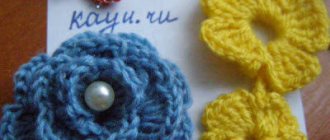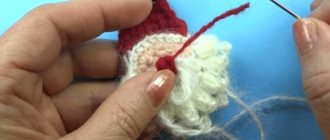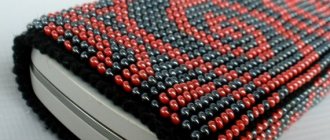Who is this article for?
For those needlewomen who have never held a hook in their hands or seen how they knit. The entire knitting process is divided into stages, each with a video and description with photos.
Any questions that arise during the learning process will go away, because... There will be step-by-step descriptions, photos, and video tutorials that will help you see the whole process from the first loop to the finished work.
If you are in doubt and think that you do not have the skills, then you should definitely knit with us.
We offer you our own version of the answer to the question of how to crochet a phone case for beginners.
This article answers the questions:
How to crochet a cover for beginners who don't know how to knit? Where to start knitting a cover? How to choose a hook and thread? How to make your case a unique piece of envy?
What loops should I learn to knit? How to hold the hook? How to finish knitting? How to decorate a case? How to make a clasp? How to tie a mount or carrying handle?
What useful secret should your case have?
If you don’t have either thread or hook, we recommend purchasing it in one place so that you can choose the right one.
Let's look at the simplest variants of covers, they will differ only in color and decor, the rest of the details will all be the same. Look at the photo and choose the one you like most, now let’s look at other important aspects about your case.
If you decide to decorate your case with flowers, then the next article will tell you in detail how to crochet a flower for beginners with detailed photos, videos, and diagrams.
For lovers of keychains in the shape of crowns, we recommend watching detailed step-by-step master classes with crocheted crowns; all instructions are described here.
Simple and unique crocheted toys for beginners can become a wonderful keychain for your case, as described in this article.
Who is your case for?
Determine who will be the owner of your first case and what tasks should it solve?
Master
Child: tight with a secure, simple closure (button or drawstring), fun decorations and be the main favorite character or animal.
Woman: beautiful and convenient, easy to reach even with long nails (the button) when in a hurry, match the color of the bag or blend harmoniously with clothes, be the envy of your friends, protect your phone from scratches, with a keychain.
Man: dark colors, made of dense thread, with a minimum of decorations, indicate status or profession, preferences, carry on a belt or in a bag, pocket.
Clasp options
To wear it as an accessory around the neck, choose a long cord. The quality of the lace is important - it should not scratch the skin and should be very durable. To be worn on the arm, ties in the form of a drawstring or an adjustable handle are suitable.
For reliability, the cover itself must be closed. There are several options for this:
Velcro will not work - they will cling to the yarn, creating unpleasant snags on the product. Buttons are also not the most popular clasp option - the grip is average, they may not close completely and the phone will fall out.
How to choose the right thread and hook?
We select a hook to match your threads; the size of the required hook is written on the threads.
Please note that if the thread composition is 100% cotton, then your cover will not stretch. Synthetic threads retain color longer and the thicker they are, the faster you will knit the desired height.
Why shouldn't you choose thin threads?
The purpose of the case is to protect the screen and the phone itself from scratches, impacts, or contact with anything that damages the case or screen itself. Therefore, thin threads for openwork knitting will not solve the primary task well, although they will look impressive and airy.
What specific yarn do we recommend?
Any thick acrylic (from 300 m in 100 grams), cotton (from 200 m in 100 grams), various variations with wool or other impurities. Consider the option of microfiber yarn - this is a cheaper option, Alize Diva has it (350m per 100g).
The simpler the first case is, the faster you will see the result of your work, so let's get started.
Choosing the right model of crocheted phone case
At first glance, choosing a crocheted phone case model is very simple. After all, you just need to guess the exact size. But no, because each person is individual in his own way, each has his own tastes and preferences. But, nevertheless, based on the gender of the person, you can choose the appropriate option.
- Case for a child. You need to find out what he likes. Most often, it can be a cartoon character or some animals. Then everything depends on your imagination and skill. Such a case can be decorated as much as possible with various details, beads and other attributes. But it should be in a boy's or girl's area. That is, a guy even at 7-8 years old does not need to attach flowers. Let it be a funny minion or a character from Angry Bears.
- Girls, don't be afraid to use a variety of girly things. Therefore, we attach ears, bunny tails and various shiny objects.
Version for boys
Important: The knitting must be tight, since children are very mobile and will not do without falls, but the phone must remain intact.
And this is already suitable for little princesses
- Case for a man. For men, a cover knitted with threads in dark shades is best suited. It will be more difficult to choose a model than for a child, but it is quite possible. The main thing is to know his hobby or knitting, based on his profession. It is better to exclude decorations or reduce them to a minimum so that they are less noticeable. The best option would be if the case you made can be carried in a pocket or backpack (bag). This will make the man more comfortable.
- Since modern women are very mobile and are often on the move, they need a cover that can be fastened and opened.
Stylish and simple
What we are given to get the finished case of your child’s dreams:
- Hook.
- Threads.
- Hands of a knitter who doesn't know how to knit.
- Availability of the Internet and the ability to use search engines such as Rambler, Yandex, Google.
The result of the solution is a finished case for a mobile phone.
First, you need to measure your phone and enter the required dimensions into the picture. You can also eyeball the phone and start knitting the case, but if you didn’t guess correctly, you’ll have to re-bandage it.
After drawing a picture, we put down the dimensions of the phone. By looking at the composition of the threads or by pulling the thread between your hands, we determine whether the thread will stretch.
To make the phone fit easily into the case, add 1-2 cm to the width.
We will check this during the knitting process.
You can add 3 cm to the height of the cover so that it cannot fall out. Whether or not to add an increase depends on the fastener we choose next. Let's get to work!
Openwork case
Cute knitted phone case - master class by Elena Khorolskaya.
If you pull the light part when opening the case, the phone will automatically come out of the case. This is very convenient when you need to answer a call urgently.
We need:
- hook No. 1.4 – 2.0
- linen threads of two contrasting colors - main (burgundy) and additional (white).
Accepted abbreviations:
- STSN - double crochet
- STBN - single crochet
- VP - air loop
- *…* — pattern repeat.
Cast on a chain of 24 loops.
Row 1 – work 22 SC. In the last loop, knit 3 SC. Then turn the knitting and continue to knit in the round 22 SC. Work 3 SC into the last chain stitch.
Rows 2-8 – knit 50 sc each.
Row 9 – start knitting an openwork insert. Knit 3 dc, skip 1 loop, knit 1 dc in the next loop, *2 ch, 1 dc, knit in the same loop as the previous one, skip 2 loops and knit 1 dc in the next loop.* Repeat pattern repeat 5 times. Make 2 ch and knit a dc in the same loop as the previous stitch, skip a loop and knit another 29 dc.
Rows 10-16 - knit a dc above the dc of the previous row, and knit 1 dc in the chain arch of the previous row, * cast on 2 ch and knit 1 dc, then work 1 dc in the next chain arch. * Repeat the pattern 5 times. Then connect 2 VP and 1 DC and 29 DC.
Rows 17-24 – work 50 SC.
Row 25 – knit with the pattern: 1 DC, *then skip 2 loops and knit 1 DC, cast on 2 VP and knit 1 DC*. Repeat the pattern 10 times. Skip 2 stitches and work 1 dc and cast on 2 ch.
Row 26 – knit 3 DCs between the columns of the previous row, *tie a DC into the air arch, tie 5 DCs between the columns of the previous row*. Repeat the pattern 10 times. At the end of the row, finish the first fragment; to do this, tie 2 DCs into the first air arch. Move the thread to the wrong side and tie. Cut off the excess.
Turn the product inside out and use a thread of the main color to knit 1 row of 20 STBN, inserting a hook into the last row of STBN (about 2-3 cm from the bottom of the cover) on the half of the product that does not have an openwork insert.
Knit rows 2 - 16 with a thread of an additional color 20 STBN.
Knit 17 – 24 rows with a pattern: skip 2 loops, knit 1 DC, then 1 VP and again 1 DC.
Having finished the 24th row, do not break the thread, but turn the knitting and continue tying the resulting fragment: openwork part - 3 VP, 1 STBN; the solid part is STBN. Fasten the thread and cut off the excess. Then tie the opposite side. Starting with the solid part, work SC.
The openwork part will cover the phone, so it needs to be decorated further. To do this, crochet 1 SC in the air arch of the first row of the fragment, and 5 SC in the next arch, alternating with 4 VP.* Repeat the pattern 10 times.
At the corners, instead of 5, knit 7 STSN. Fasten the thread and cut off the excess.
Turn the cover onto your face. So that the phone can be hung on your shoulder or around your neck, you can tie a ribbon. To do this, fold the thread of the main color into three folds and knit a chain of VP of the required length. Then sew or tie it on the inside of the cover.
Now the cell phone case is ready. Enjoy!
Another beautiful option is a handbag-case:
Step-by-step recommendations for knitting
- We search on the Internet or on free hosting sites, for example, youtube.com, for a video on how to knit air loops. There are pictures on many forums, but it’s hard to understand the principle from them. When purchasing threads and a hook, you can ask the seller to show 2 types of loops: air and single crochet.
For our readers, we provide a video on how to start knitting and knit air loops just below.Pay attention to the video tutorial, masters hold the hook in different ways. We suggest placing your hands as in the photo, holding the hook and threads loosely.
2 methods of casting air loops
Option I Start with an air loop. Make a loop by holding the end with your fingers, thread the hook through it and twist it twice. Now pull this thread into the loop and this will be the 1st air loop. Video on how to knit chain stitches and start knitting: option II
Wrap the thread around your index finger. We crochet the thread coming from the ball into the resulting ring. We get the 1st loop by pulling it out and tightening it.
- How to start knitting and cast on a chain of air loops is shown in the video tutorial with detailed explanations
- Video on how to knit a connecting stitch
- Next we knit in the circle with single crochets. We knit until the length of your case is equal to the length of the phone + 2 cm. You can easily check it by placing your phone in the resulting case, it should be completely closed and slightly longer than the phone.
Photo of how to start crocheting a cover
We knit a chain of air loops
Wrap the thread around your index finger, place the knitting on your index finger, and move the chain down as you knit. Hook the thread and pull it through the loop.
Having studied the principle of casting on loops, knit the required length according to the width of your phone, add 1 or 2 cm.
If your phone width is 5 cm, then you can add 5*2+ (measure the side of the phone). Or 5*2+2cm=12cm.
We choose for a width of 5 cm, the length of the chain of air loops is 12 cm, in this case the phone will easily fit into the case.
To be completely sure that you did everything right, you need to: take the resulting chain and wrap it around the phone widthwise.
If you don't have enough to reach the edge of the phone, add more loops; if there is a slight excess, then that's good. It is necessary to close the resulting chain into a ring. You do this using a connecting stitch (half single crochet). Watch the video to see how it is knitted.
Connecting post
We overlap the beginning and end of the chain, thread the hook through 2 loops at once and immediately pull out the thread.
Single crochet
We pass the hook through the loop of the previous row and, grabbing the thread, pull out the loop. There are 2 loops on the hook, once again we pull the hook through them and pull the thread, 1 loop remains on the hook. Look at the photo and video tutorial to repeat on your knitting.
Crochet patterns for various cases: for phones, chairs and even vases
View > Home / Napkins, tablecloths, Knitting patterns, Knitting for the home, For the kitchen, For beginners, Miscellaneous, Napkins and tablecloths, Knitting for the home, Napkin patterns
03 Nov 2022 Category: Napkins, tablecloths, Knitting patterns, Knitting for the home, For the kitchen, For beginners, Miscellaneous, Napkins and tablecloths, Knitting for the home, Napkin patterns
your feedback
A skilled craftswoman of crochet needlework will “dress” any little thing in a case – from your favorite smartphone to a cute vase that serves as decor in the corner of the room. Although, in terms of the degree of complexity of knitting, covers are among those items that can be done even by beginners holding a hook in their hands for the first time.
Of course, you should start with the simplest thing - knitting a case for a mobile phone. Having mastered the basics of crocheting, many needlewomen move on to more complex levels: knitting covers for stools, chairs and even car seats!
Today we will take you into the world of crocheted covers. Perhaps, let's start with the most popular - cases for smartphones in different variations (step-by-step photo master class, as well as a detailed description of knitting openwork cases). Next, we will invite our readers to try knitting chair covers (fillet technique and mosaic from squares) and will end with a master class for professional craftswomen - detailed instructions for making a decorative cover for a vase.
Mobile phone cases
Here the imagination of the craftswomen has no limits. Cases for smartphones and phones can be anything: simple and multi-colored, with drawings or knitted relief motifs, as well as in the form of your favorite cartoon characters and other popular characters.
When starting to create such a case, it is important to remember that its main purpose will be to protect the screen and body of the phone from scratches, bumps, and falls. Therefore, you need to select the right yarn that can create a strong knitted fabric. In this case, thin threads for openwork knitting are not suitable; it is better to choose acrylic or cotton yarn of medium thickness; you can also consider combinations of threads with wool or merino. We select the hook according to the thickness of the thread.
Abbreviations in the text:
- VP – air. a loop;
- Runway - air. lifting loop;
- Art. s/n – double crochet;
- Art. b/n – single crochet;
- Art. s/2n – double crochet stitch;
- pet. - a loop;
- flail - chain;
- PR – previous row;
- SS – connection column.
So, let's start knitting!
Step-by-step master class on knitting a simple thick cover
First you need to measure your smartphone and cast on the appropriate number of loops to cover its front side in width. For example, take 25 VP. Take the main thread and knit st. s/n (in each stitch - 1st column).
As soon as the knitting reaches the last. pet. the base is a chain, you need to knit 9 tbsp into it. s/n. Next we go in a circular manner, tying the base chain on the second side - all the same st. s/n in each pet. flail At the “turn” - again 9 tbsp. s/n. Total we get: (50 + 18) = 68 loops. This number of loops will remain the same throughout the entire knitting process. Track. We knit 2 rows st. s/n (in each stitch - 1st column). In the end, it should look like this: We attach the yarn of the desired color, do not cut off the main thread, leave it on the wrong side of the work. We knit a trace. way: 2 tbsp. b/n, 3 tbsp. s/n, stretched from the 1st row of knitting. Track. we knit a row with regular stitches. non-woven yarn of the same color. Track. We knit a row with a thread of the main color, according to the pattern (make sure that the relief alternates) using the combination already known to us: “2 tbsp. b/n, 3 tbsp. s/n, drawn from the “color” row of knitting.” We get this pattern: We knit all subsequent rows in the same way
As soon as the case reaches the desired height (almost covering the smartphone completely), we begin tying: knitting, alternating. s/n + 1 VP. We finish knitting with two rows of st. b/n. We do not cut off the thread; from the end of the last row we begin knitting the lace: we cast on 60 VPs, on top of which we knit a row of sts. b/n. Stylish and reliable phone case is ready for use!
Pink openwork case for women's pens
Knitting pattern:
The case differs from the previous one in a more complex “fan” pattern.
Knitted from threads of two colors. We knit according to the pattern. We collect the flail. on 11 VP, on both sides in a circle we tie them st. s/n, in this case - in the extreme loops of the chain. knit 9 tbsp. s/n, in the remaining loops - according to the 1st st. s/n. In the second row we knit according to art. s/n - one in each loop, no additions. We continue to knit according to the pattern, do not forget to change the color of the thread, and repeat rows 5-6 the number of times until the cover reaches the desired height. Fans from s/n columns are knitted under st. b/n PR. After finishing knitting the main fabric of the cover, we knit a simple rope from VP (tie with SS or st. b/n) or a more complex decorative cord - you can use a “caterpillar” or braided one.
Openwork phone case for romantic people
Knitting pattern:
Knitting order:
We collect the flail. at 21 VP (18 VP + 3 runways). Row No. 1: 5 tbsp. s/n in the 4th VP chain, 16 tbsp. s/n in next 16 VP chain, 4 tbsp. s/n in next VP chain, 16 st. s/n on the reverse side of the chain. We finish the row with SS. Row No. 2: 3 runways, 1 st. s/n in next s/n PR, 2 VP, 14 rapports: “1 tbsp. s/n in the 2nd art. s/n PR from hook, 1 tbsp. s/n in next Art. s/n PR, 2 VP.” SS. Row No. 3: 5 VP (3 VP + 2 VP), 12 repeats: “2 tbsp. s/n in next arch of 2 VP PR, between the columns - 2 VP.” SS. Rows No. 4-16 – knit according to the pattern. We knit a lace: from one VP, we knit rapports: “3 VP, 2 unfinished. Art. s/n, knitted together on one stitch. base" until the desired length is reached. We thread the lace between the arches of the 15th row, close it in the ring SS., cut off the thread and hide it inside. We thread a satin ribbon into the arches of the 8th row and tie it in a bow.
Patterns and detailed instructions for knitting covers for stools and chairs
Almost every home in the kitchen has boring stools that have lost their appeal over time. With the help of a hook you can restore them not only to their former beauty, but also add original notes to them. By tying stools to match the color scheme of the kitchen interior, you will be able to create an absolute feeling of comfort and warmth in the kitchen.
Decorating chairs and stools with your own hands is extremely simple, see for yourself!
Step-by-step lesson on knitting a stool cover using a mosaic pattern of squares
This pattern must be crocheted from the center, in the shape of a square. The color of the yarn is selected individually; it needs to be changed after every two rows knitted. Thanks to this knitting, a mosaic pattern is obtained.
The benefit of knitting colorful stool covers like these is that you can use up leftover yarn from previous knitting projects.
Knitting progress:
Twist the self-tightening ring. We knit 1 tbsp into it. s/n, and immediately knit with rapports into a ring: “4 runways + 4 tbsp. s/2n, united by one top + 4 VP + st. b/n". There should be 4 rapports in total.
We finish row No. 1 with a SS, proceed to knitting the 2nd row: we find the top that unites 4 sts. s/2n PR - we knit a trace from it. rapports (4 p.): “12 tbsp. s/2n + SS in st. b/n PR". The end of the row is SS. Change the color of the thread.
Row No. 3 is knitted from a corner fan of 12 stitches. s/2n (count 4 sts. from the beginning), knit with rapports to the end of the row: “4 runways, 4 sts. s/2n, united. with one vertex (attention: the hook is inserted from the back of the stitches!), 4 VP, SS in the next. pet., 8 relief. Art. s/2n, 4 VP, SS.”
Row No. 4: knit with rapports to the end of the row: “12 tbsp. s/2n from the top of 4 sts, PR, 8 sts. s/2n from the top of the 8th st. ETC". In the corners you should get arches of 12 sts., on the sides - 8 sts. SS. We cut off the thread.
Row No. 5: Attach a new color of yarn to the corner fan. We knit according to the principle of row No. 3, but we knit 4 embossed columns in the corners with a total. top, on the sides - 8 columns with total. top. Row No. 6: in the corners we knit fans from 12 tbsp. s/2n, on the sides - 8 tbsp. s/2n.
Knit the square fabric until it completely covers the stool. Next, we knit 3-5 rows with a single-color thread without increments, i.e. knit 8 stitches in the corners. s/2n. After finishing knitting the cover, you can knit two ties in the corners (we collect a chain from VP, tie a st. b/n), 8 pieces in total. In addition to the kitchen interior, you can knit oven mitts and hot pads using the same pattern.
Chair cover using fillet knitting technique
Chair covers made using the fillet technique look interesting - they are sophisticated, airy, and at the same time, they can always boast an incredible pattern, similar to hand embroidery. Chair covers are distinguished by the need to knit two parts at once: the seat and the back.
Stages of knitting a cover:
Back: pick up the flail. of 123 VPs (118 VPs + 3 VPs + 2 VPs). Row No. 1: 1 tbsp. s/n in the 9th VP chain. from the hook, 2 VP, to knit the fillet cells, repeat the following 39 times. rapport: 1 tbsp. s/n in the 3rd VP main. chain, finish st. s/n. We perform rows No. 2-54 with fillet stitch according to pattern No. 1, in the forward and reverse directions, not forgetting about knitting the swan pattern. Row No. 55: add 9 tbsp. s/n. We continue knitting according to pattern No. 2, knitting from rows 1-49 inclusive. Seat: attach the thread from the back side of the base. flail back and knit straight and back using the fillet technique according to the seat knitting pattern (rows No. 1-44). Assembling the cover: sew the side seams. We tie the free sides of the cover according to the binding pattern in 6 rows with an openwork pattern.
Exclusive vase case
You can also “dress” your favorite vase - the openwork cover made of thin strands is real proof of this! And if you knit several of these accessories in different colors, you can choose a matching “robe” for each vase.
Knitting pattern for a vase cover
Progress:
We start with the chains. on 32 VP, close the SS into a ring. Row No. 1: 1 runway, 31 st. b/n in the ring. SS. Row No. 2: 1 runway, 31 st. b/n in each pet. ETC. SS. Row No. 3: 4 VP (3 VP + 1 VP), 16 repeats: 1 tbsp. s/n in the 2nd art. b/n PR, 1 VP. SS. Rows No. 4-5: 4 VP (3 VP + 1 VP), 16 repeats: 1 tbsp. s/n in next Art. s/n PR, 1 VP. SS. Row No. 6: 3 Runway, 3 tbsp. s/n in the arch from 1 VP PR, 16 rapports: 1 tbsp. s/n in next Art. s/n PR, 3 tbsp. s/n in next arch from 1 VP PR. There should be a total of 64 tbsp. s/n. SS. Rows No. 7-33: knit according to the pattern, completing each with a SS. Petal (8 pieces): made of chains. on 14 VP we knit five rows according to the petal knitting pattern. We assemble a vase: we form a flower from eight petals, sew it to the vase, and decorate it with a bead or rhinestone. We thread the satin ribbon into the fillet cells. We put the cover on the vase; for convenience, you can fix its correct position with a glue gun.
Video tutorials on crocheting covers
Crocheted covers are very popular among needlewomen, so there are plenty of master classes on this topic online. We have collected the best of them:
We also recommend:
- Knitting trends 2022: patterns, materials and new things
Like? Press!
Tags:
Bottom of the case
Now we tie the bottom of the cover so that there is no hole at the end. This is done using a single crochet, covering both sides of the product. We finish the product, leaving a thread 3-5 cm long. Watch the video to see how to finish the product and hide the thread.
The video will teach you how to finish knitting and hide the thread:
The finished case knitted according to this description should look like this.
How to knit a phone case in a circular pattern
If you want to make a seamless product, you should prepare four hosiery needles. Of course, it is more convenient to make such an accessory using a hook. But if the needlewoman does not know how to handle this tool, there is no need to be upset, because you can do without it. To make a seamless case, you need to cast on the knitting needles a number of stitches equal to not one width of the mobile phone, but two. After that, we distribute them onto four knitting needles and knit the accessory, moving in a circle. When two rows remain until the end of the product, calculate the number of loops to decrease: divide the total number of loops by two. This way we find out how many loops need to be closed in each row to make a neat bottom edge.
If you want to make a cover with a fastener, you should cast on half the required number of loops on the knitting needles and knit several rows. Then add the remaining loops and distribute them onto four knitting needles. Then knit using the technology described above.
How will we carry the phone?
The case is almost ready, but now you need to decide whether you will wear it around your neck, on your belt, or just in your bag?
For wearing on a belt, we recommend tying a second holder.
Let's consider 2 options:
- in the form of a backpack;
- with two handles tied to the edge.
In 1m - this is one hand tied to the edge of the cover, and then from 1 way divided, we get a double one, attached to the bottom of the cover. Using a ring allows the handles themselves to be made wider than the original upper part.
To wear around the neck, choose a long cord. It is important to understand that in this case the quality of the threads will be extremely important, since yarn with lurex scratches the body and is not pleasant to the skin. If you like to wear it on your hand, then make the following ties:
- in the form of a puff;
- adjustable simple handle.
It is preferable to use a clasp if the clasp is without a flap, so the phone will definitely not fall out of the case.
Case with valve
Dimensions: 9cm by 12cm.
We will need:
- yarn “Iris”, 100% cotton, beige – 10g;
- some pink yarn;
- hook No. 1.25;
- beads – 4 pcs. green, 4 pcs. pearl color;
- decorative roses – 6 pcs.
Description
Using beige yarn, we make a chain of 20 air. p. (= 17 chain stitches + 3 chain stitches) and knit:
- 1st row: 1 dc in the 5th ch of the chain from the hook, 14 dc in the next chain. 14 VP of the base of the chain, 5 Dc in the next one. VP of the base of the chain, 15 Dc in the next. 15 VP of the base of the chain on the reverse side, 4 Dc in the next. VP of the base of the chain from the hook. We complete the row with a connecting column.
We carry out further work according to the circular pattern up to the 14th row inclusive. Every r. we complete SS. Next, we divide the canvas into two parts in half. We knit the valve in straight/reverse rows according to cx. from 13r. 22 rub. We cut the thread.
Harness
We connect the pink yarn to the upper edge of the cover and knit 1 row of sc in the round. We finish it with Sst.
We cut the thread.
From a beige thread we knit a chain of VP of arbitrary length. We connect the finished cord to the connection case. stlb.
We decorate the case with ready-made roses and beads.
How to knit a case for beginners instructions + diagram
- Knit a chain of chain stitches equal to the circumference of your phone.
- Using single crochets we knit a pipe equal to the height of your phone, more or less as you wish.
- We tie the edge of the pipe with half-columns to get a cover.
- Make a clasp.
- Tie a chain or other option for wearing.
- Decorate the case.
That's it, your case is ready, you can decorate it with various leaves, flowers or pom-poms by watching the video tutorials below. Congratulations, your unique and exclusive case is ready!
Golden case
Dimensions: 6.5cm by 11cm.
We will need:
- yarn, 100% cotton, peach color – 20g;
- yarn “Travka”, 100% polyester, golden color – 10g;
- hook No.2;
- blue beads.
How to crochet a phone case
Using a peach thread we make a chain of 20 air. st. (= 17 air sts. base + 3 air sts. rise) and knit:
- 1st row: 1 stb s/n in the 5th air. pet. chains from the hook, 15 stb s/n in the following. 15 air pet. chain base;
- from 2nd r. on 28th r: 3 air. lift point, 16 columns with nak. in the next 16 columns with nak. previous row. We cut the thread.
Assembly and finishing
Fold the finished fabric in half. We connect the “Grass” yarn and knit on both sides according to the connection pattern. We tie the upper edge of the cover in a circle 1 r. pillar. without nac. We complete the row of connections. pillar.
We do not cut the thread, but knit a chain from the chain. pet. arbitrary length.
Star
Make a star from blue beads according to the diagram. Sew it onto the cover.
How to decorate such a simple case?
This little case easily turns into a mouse or a bear, a cat or a Minion, or a dog. To do this, we select the right threads by color. Then we sew on the missing parts by tying the eyes, paws, ears or nose.
Knitted bag for tablet with jacquard pattern
In order for all devices to be in the same style, we will also knit our own bag for the tablet in the same color combinations. Here we use a pattern that is used in the east to decorate ceramic tiles.
Note: the tablet case is knitted very tightly. In addition, it will be slightly smaller than the device itself, this is necessary so that it is well packaged.
| Size | S | M | L | XL |
| Width(cm) | 23 | 31 | 35 | 47 |
| Height (cm) | 28 | 28 | 28 | 37 |
Hide the remaining ends of the yarn. Wet the work, remove excess water by wrapping it in a towel and rolling it, pin it to size, and dry it. Turn inside out, sew. Fasten the clasp.
Jacquard knitting pattern
Below is a counted pattern for the knitting pattern on the tablet case. I apologize, but the diagram was taken from a German magazine, so it is not in Russian. But I think that everything should be clear to knitters.
On the left in Figure A is the main pattern, which is used for both a small phone case and a large tablet case.
The triangle on the top right is a pattern for the flap of the tablet case. Below it is a pattern for knitting the flap of a phone case. At the bottom left is a stripe pattern at the bottom of the mobile phone case.
The letters A, B, C and D indicate the four colors that we will knit with. You can take others. If only they fit well and harmoniously with each other.
Counted patterns are numbered for knitting rows. We knit the large cover in circular rows, and the small one in regular rows.
Felt and felt tablet case, bags with animals
Wonderful bags - cases for gadgets - tablets and phones can be made from natural material made using wool. It is supposed to be sewn on a sewing machine, but it is possible by hand, but it will take more time. The main thing here is to think carefully about the pattern scheme, as well as the color combination.
How to sew a cover for the head of a bed
Now it's not about phones. What to do if you need to update an aged, worn upholstered backrest? Without further ado, let’s start sewing the cover. If you have the right material for the job at home, the cost will be minimal. You will need a sewing machine, as well as some sewing skills. For the fastener, you can simply sew on ribbons or laces if you don’t want to fuss with buttons or snaps.
We sew pockets for a phone and a wallet into a bag made of fabric
Simple square fabric bags, canvas or linen bags, so-called eco bags, always lack pockets. For phone, wallet, keys, glasses, combs. Everything is in a big pile inside, and if there is a lot of stuff there, for example, food, then the most necessary things are difficult to find. Just sew large pockets inside.
How to completely reduce the time needed to create the image of a living creature?
Glue on ready-made eyes; they are sold in craft or stationery stores. Make a mouth out of cord or sew on a button.
For those who want to put a little more effort into making a case, we provide video tutorials on knitting jewelry.
Crochet flowers and butterflies
The video tutorial will help you crochet a flower for beginners and decorate your case
Crochet butterfly
A step-by-step video tutorial will help you figure out how to crochet a butterfly
panda paw
Video tutorial on how to knit a cover decoration
Step-by-step knitting decorations
Kitty face
How to crochet a phone case: 5 patterns with descriptions and diagrams
How to crochet a phone case: 5 patterns with descriptions and diagrams
A crocheted phone case looks beautiful, unusual and is a very convenient thing.
Even if you just want to learn how to crochet, then such a case is the best way to train your hand.
Therefore, we want to share the main knitting secrets in this material.
Case Minion
Necessary materials: for the cover, threads of 3 colors black, blue and yellow of the same thickness, for finishing - white, gray, black, hook.
We start knitting from the top yellow part. We cast on 16 air loops. And we knit a strip of chain stitches.
The bottom of such a case is blue or light blue, and the top is yellow, retreating 2 rows from the top, tie 1 row with black threads, so you will have a thread for glasses.
Embroider the mouth with black thread 2 stitches.
The pants need straps; we make them from air loops, having reached the middle of the length, we crochet them in the right place in the middle and, having knitted a single crochet, we continue knitting in the same way.
We also fasten it on the reverse side. We hide the remaining threads on the inside.
More cover options
3 Video tutorials on knitting a cover without a seam
With dragonfly button decoration
Knitted case for tablet
A tablet is even more susceptible to impacts than a phone due to its large screen. A knitted cover will provide additional protection for it. It is easiest to do on knitting needles or sew from soft fabric. Only such a case will need a rigid insert; it can be made of hard cardboard, plastic or hardboard. Even the remains of thin drywall will do. The cover is made of four rigid parts that will fit the front and back parts, as well as the sides along the long side. The fifth part is the cover.
Each piece needs to be covered with fabric or tied. Next, you will need an elastic tape, from which “ears” are made at the corners of the lower part for inserting the corners of the tablet. On the other side of the same part, you can make a clamp for the lid from an elastic band. The second option is to use Velcro. It is appropriate to provide a knitted cover with a button closure or zipper. Then it can be made without a lid.
Examples in pictures
The difference in the technology for making knitted and woven covers is that for the first you need to tie each rigid part separately, and then crochet them together. For the second option, you can use panels of fabric along the entire length of the product.
With transparent wall
It’s very inconvenient when the phone rings and you don’t know who it is or you receive a message on Viber, in order to read it you need to take out the phone, which is extremely inconvenient.
We suggest knitting you a case for your iPhone (iPhone) in which the front side will be transparent.
You will need: plastic or a book cover or a transparent folder, threads, a hook, an awl or a thick needle to make holes, check that the hook fits into these holes.
If your phone responds to touches through this plastic, then we recommend that you pack it with a lock so that you can take it out only when you need to remove the battery.
In this case, do not forget to make a hole for the camera and chargers during knitting.
Step-by-step instruction:
- Trace the phone by placing it on the plastic or cover. Leave allowances for knitting and holes.
- Cut out a shape of the required size, make holes in it around the perimeter, with the exception of the top part, if you plan to take it out and make it open.
- We start knitting, from the first air loop we thread it through the hole and tie it like fabric.
- Then knit from right to left, clinging to the side holes to the top. When trying on a phone case, you need to knit it tighter or looser to see. Knitting single crochets or any pattern that interests you. The fastest knitting is double crochet
- We knit the bottom with this knitting, you don’t have to grab the plastic, when you knit the bottom from side to side in rows, at the height you need, go to the loops on the sides, just like you knitted at the bottom, tie up the side parts.
- So knit until the end of your plastic or oilcloth.
- Decorate the top part or leave it undecorated. You hide the threads and finish knitting.
- If desired, attach a handle to the side for the board on the shoulder, like a handbag.
If the threads are thin, then knit 2-3 times into 1 hole; if they are thick, then 1 loop is enough. Place the tail of the thread inside the knitting, as in the photo.
There is also a very effective option: you knit a leaf or a flower, tie the cover itself, as disassembled above, and connect the flower and the tied cover with small cells of air loops, it will turn out approximately like in the photo.
This knitting is called Irish lace, an example of knitting in the video:
DIY phone case - the simplest options
An original phone case can be made from scraps of suede or leather. You need to cut out two plates and punch round holes in them, like for buttons. It is advisable to pierce it with a heated tube so that the skin does not crack later. The plates can be connected with thread using a crochet hook. It must be carefully inserted into the holes so as not to tear the edges. You can also tie it with rainbow elastic bands if you have a special hook in your arsenal. Lacquered leatherette will look good with elastic bands. You can use felt instead of leather if you prefer a matte texture.
For the case, you can make a cover secured with Velcro. Tie the lid around the edge with the same material that connects the main plates.
No less original is the shockproof case made of thermal adhesive. The basis of this glue is polyethylene. Today you can buy not only colored rods for a special gun, but even with the inclusion of the smallest particles of metal. Initially, this was done for technical purposes, but hot-melt glue turned out to be so aesthetically pleasing that it began to be widely used in the creation of Christmas tree decorations.
To create such a case, you will have to wrap your phone in heat-resistant paper or parchment. On this material you need to draw the places where the gadget has connectors, a camera lens, a microphone, an earphone, and a flash (it also plays the role of a flashlight). Leave a “window” for the logo – if desired. Now let's start applying hot melt adhesive. We circle the designated places to leave them free. We fill the rest of the space with patterns. They can also be drawn with a pencil on parchment in advance. You need to work quickly so that the glue hardens at the same time, otherwise you will not be able to achieve a connection between the individual parts of the ornament.
Case made of beads or with beads
Beads will help turn even a simple case into a masterpiece, but working with beads is especially labor-intensive if you plan to knit according to a multi-colored pattern. First the beads, i.e. the whole picture must be folded in rows and strung on a thread and only then knitted.
For beginners, we recommend knitting a simple case and only after filling your hand, move on to beads, because... At the stringing stage, everything can and will end.
When choosing beads, it is important that your threads pass freely through the beads and that you can move them, because during the knitting process, it is convenient to pinch not just one bead with your finger, but several at once.
Case decoration options
When the base is ready, you can start decorating. Here you don’t have to limit your imagination, using different techniques:
- Tie on additional elements and sew them onto the base. This way you can create a cover in the shape of an animal’s face or simply with colored knitted circles. The decor may well go beyond the cover itself, for example, you can make paws or ears.
- Sew decorative elements from felt. This material does not crumble along the edges and is easy to cut, so you can create an excellent applique from it.
- Make bead embroidery, attach beads, spikes, etc. Here it is worth using small-sized elements to make the case convenient to use.
- Make tassels from bundles of thread.











